You are using an out of date browser. It may not display this or other websites correctly.
You should upgrade or use an alternative browser.
You should upgrade or use an alternative browser.
Is -30 degree the same as 330 degree?
- Thread starter Indranil
- Start date
Dr.Peterson
Elite Member
- Joined
- Nov 12, 2017
- Messages
- 16,051
Is -30 degree the same as 330 degrees? I am confused.
For many purposes, the answer is yes: because the angles are coterminal, if all you care about is direction, you can call it either one.
Sometimes, you care about how far you have turned to get to a direction, and then you would consider them different.
What is the problem you are working on?
I am working on the directions of vectors.For many purposes, the answer is yes: because the angles are coterminal, if all you care about is direction, you can call it either one.
Sometimes, you care about how far you have turned to get to a direction, and then you would consider them different.
What is the problem you are working on?
mmm4444bot
Super Moderator
- Joined
- Oct 6, 2005
- Messages
- 10,902
Measured from standard position, a vector at 330° is the same as a vector at -30°. They each point in the same direction because they're the same vector. It's the rotation that's different. Measured as 330°, the vector has rotated counter-clockwise, from standard position. Measured as -30°, the vector has rotated clockwise, from standard position.I am working on the directions of vectors.
Either way, the vector (i.e., terminal ray of angle) ends up in the same place. This is what is meant, when we say 330° and -30° are coterminal.
I encourage you to read some beginning lessons on trigonometry. It will help you understand basic vocabulary and definitions. Cheers :cool:

